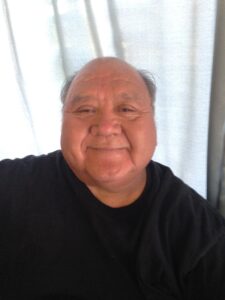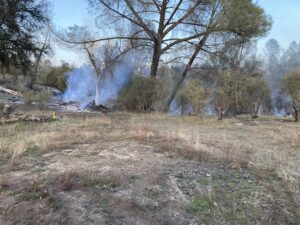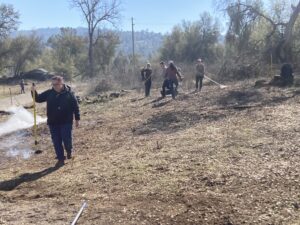
Photo provided by Ron W. Goode

Photo provided by Ron W. Goode
A future where cultural burning and prescribed burning are practiced side by side — one cultural burning leader in California describes this as the ideal outcome in a state where extreme wildfires are becoming the norm.
Earlier this year, several dozen small fires burned through 50 acres in the small unincorporated community of Mariposa, California. Over 100 people watched the flames, yet no one complained or rushed to put out the fire.
That’s because these weren’t your typical fires — instead, it was a cultural burn, conducted by Tribal Cultural Burners to rejuvenate native species like the oak tree and stimulate regrowth of resources for medicinal and cultural uses. Cultural burning involves small-scale burns often targeted toward a specific plant resource and is careful not to destroy the vegetation outright.“
Nobody in the valley even knew we burned,” The Honorable Ron W. Goode, Tribal Chairman of the North Fork Mono Tribe in Central California, said. Goode has led countless cultural burns, all of which are intended to produce minimal smoke and create defensible space, or an area of less flammable plants. This practice mitigates fire risk amid intensifying fire seasons without detrimental impacts to surrounding areas.

But throughout his 40 years as Tribal Chairman, Goode says he has encountered relentless resistance to cultural burning from federal and state agencies that manage wildfires, like the U.S. Forest Service (USFS) and the California Department of Forestry and Fire Protection (CAL FIRE).
Goode is no stranger to these federal agencies, having worked on the Dinkey Collaborative, an alliance between the USFS and various tribes in California to restore the landscape in the Sierra National Forest. However, these agencies won’t budge when it comes to cultural burning, as they’ve continued to restrict its practice and it still isn’t permitted on most federal lands.
At first glance, this resistance might seem surprising: Cultural burning has been shown to yield positive impacts for the environment and bears significance for Indigenous populations in California and across the country.
Yet these agencies’ stringent regulations on cultural burning aren’t a surprise to Goode, given the long history of institutional disparaging of this practice. The U.S. government throughout the 19th and 20th centuries criminalized cultural burning, alleging that Indigenous communities were “the hand of the incendiary.”
Instead, state agencies have mainly championed the prescribed burning method, which is markedly different and creates a spate of negative effects. This involves compiling huge piles of fuel, a collection of dry brush “as big as a house,” according to Goode.
This strategy can lower the risk of a wildfire occurring in an area, meaning there will be less material that could start or exacerbate one. However, these prescribed burns, according to Goode, could be significantly harder to control due to their size, especially when combined with high winds. For example, the 2022 Calf Canyon/Hermit’s Peak blaze in New Mexico, which started as two prescribed fires, jumped containment lines and burned 341,000 acres — the state’s largest wildfire in history.
In addition, the devastating heat from the large amount of material burned in prescribed burning destroys soil microbes, resulting in a hostile environment for plants. The destruction of these microbes, while invisible to the naked eye, can have visible, cascading impacts on an entire ecosystem — starting with the absence of plants, which depend on microbes for basic functions such as nitrogen fixation and nutrient cycling.
With all these risks, why do the USFS and CAL FIRE still practice prescribed burning in this way? To Goode, these policies are reflective of the agencies’ role as managers of the land who make decisions based on economics. In fact, their budgets increase based on how much acreage they can burn in a year. Not to mention that these entities still grapple with their historical precedent of deprioritizing Indigenous ecological knowledge.
“Until the economics mindset changes, we’re not going to make vast changes on the land and we’re always going to have extreme wildfires,” Goode said.

This difference in mindset triggers distinctions in approach downstream.
“When you do cultural burning, you’re burning for the resources and in a much different manner than burning for acreage,” Goode said. The pernicious misconception is that they’re one and the same — when their philosophies and methods are fundamentally different and distinguishable.
For cultural burners, small piles are the key to prevent the soil-scorching impacts of prescribed burns and to keep the flames from ever burning out of control.
“Our piles, we call them ‘beaver huts.’ If I see one that’s over six feet tall…someone’s going to be getting in trouble,” Goode said. “My leaders, who have been training for years, can’t make those kinds of mistakes.”
Goode and other cultural burners will often conduct 45–70 small-scale burns each outing, with acreage limited to 50 acres at most. He is adamant that the small scale is evident that “we get the job done and we get the job done right.”
Because Tribal Cultural Burners aren’t conducting large burns for acreage, they don’t need to have extensive firefighting gear and multiple fire trucks waiting in the wings. According to Goode, the fact that federal and state agencies have all this equipment at the ready for prescribed burns, in contrast, shows that they actually shouldn’t be burning in the first place because they are already at risk.
“You are already saying that if you light a fire, you have to have this much personnel, and this much equipment, to fight the fire that you just lit,” Goode said. “Therefore you shouldn’t be lighting a fire. But they won’t touch a prescribed fire unless they have that.”
Instead, “You need to get naked. You need to get to the point where you strip all your yellow outfits, and your fire trucks,” he said. “And then you go out and light your fire.”

But organizations like the USFS and CAL FIRE are not following suit. They continue to burn over 100 acres per outing, which Goode says greatly affects the health of those in local communities.
“When the agencies put their fires on the ground, immediately the smoke, the particles, all affect the local neighbors, and down in the valley, in the urban areas. People with health issues are stricken,” he said.
In contrast, as seen with the cultural burn in Mariposa, people are often unaware when a cultural burn takes place — again, a testament to the effectiveness of burning small piles and intimately understanding the properties of fire.
Even still, the USFS and CAL FIRE haven’t made the necessary inroads to collaborate with Indigenous cultural burning practitioners. Even worse, as mentioned earlier, cultural burners often cannot even practice burning on federal lands and when attempting to do so, face arduous bureaucratic obstacles, like going through the permit application process.
For Goode, the ideal future is one where there is more space for cultural burns, and especially where cultural burners can have a “playground” to conduct their burns. “If we had tribes doing that in their areas, in their homelands, we would have a lot more defensible space,” Goode said. “You would think that would become more important to the agencies, but it hasn’t, not yet.”
Goode pointed to the Cost Share Master Agreement in 2018 between the North Fork Mono Tribe and the Sierra National Forest as an example of what cooperation between Indigenous tribes and federal agencies could look like. Through the agreement, the North Fork Mono Tribe will be able to help restore meadows through cultural burning. “More of that needs to happen not only in the meadows, but throughout the forest,” he said.
It is becoming increasingly important that the USFS and CAL FIRE step up in crafting these agreements. California’s fire seasons are only getting longer and hotter, and the need for collaboration between managers and stewards has never been more apparent.
“We need to learn how to play together, work together,” said Goode. “When I have my burns, which is either private land or tribal land, and I invite all of the agency people to come and learn what we do…That’s the future that I see, us working together. But it can’t be on their terms, and not necessarily solely on our terms either.”